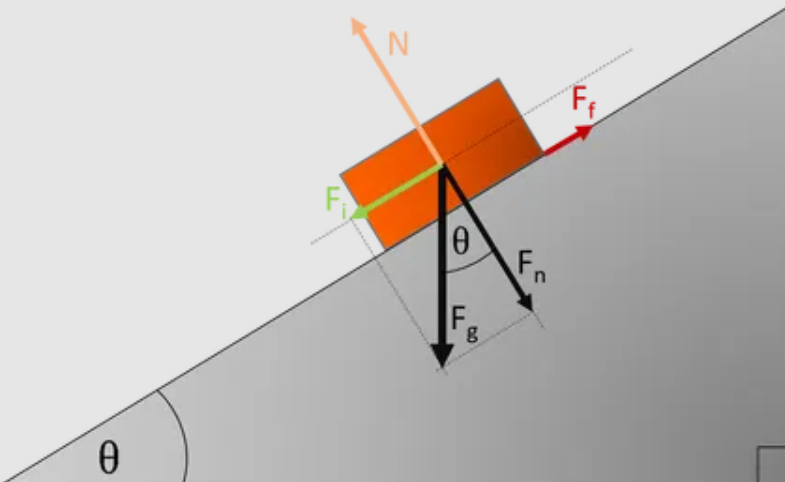1. What is a Cubic Block Inclined Plane Calculator?
Definition: This calculator determines the forces, acceleration, sliding time, final velocity, and energy loss of a cubic block sliding down an inclined plane, accounting for gravity and friction.
Purpose: It is used in physics to analyze the motion of objects on inclined planes, such as a block sliding down a ramp, aiding in understanding mechanics principles.
2. How Does the Calculator Work?
The calculator uses the following formulas:
Length of Incline:
\[
L = \frac{H}{\sin \theta}
\]
Resulting Force:
\[
F = F_g \times (\sin \theta - f \cos \theta), \quad \text{where} \quad F_g = m \times g
\]
Acceleration:
\[
a = \frac{F}{m}
\]
Sliding Time:
\[
t = \sqrt{\frac{2 L}{a}} \quad (\text{if } v_0 = 0)
\]
Final Velocity:
\[
v = a \times t \quad (\text{if } v_0 = 0)
\]
Energy Loss:
\[
\Delta E = F_f \times L, \quad \text{where} \quad F_f = f \times F_n, \quad F_n = F_g \times \cos \theta
\]
Where:
- \(L\): Length of incline (cm, m, in, ft, yd, km, mi)
- \(F\): Resulting force (N, kN, MN, GN, lbf)
- \(a\): Acceleration (m/s², g, ft/s²)
- \(t\): Sliding time (sec, min, hrs)
- \(v\): Final velocity (m/s, km/h, ft/s, mph, kn, ft/min)
- \(\Delta E\): Energy loss (J, kJ, MJ, Wh, kWh, ft-lb, kcal)
- \(m\): Mass (mg, g, kg, oz, lb)
- \(H\): Height of incline (cm, m, in, ft, yd, km, mi)
- \(\theta\): Angle of incline (degrees, radians)
- \(f\): Friction coefficient (unitless)
- \(g\): Acceleration due to gravity (\(9.81 \, \text{m/s}^2\))
Unit Conversions:
- Mass Units (m): mg, g, kg, oz, lb
- Angle Units (θ): degrees, radians
- Height/Length Units (H, L): cm, m, in, ft, yd, km, mi
- Force Units (F): N, kN, MN, GN, lbf
- Acceleration Units (a): m/s², g, ft/s²
- Time Units (t): sec, min, hrs
- Velocity Units (v): m/s, km/h, ft/s, mph, kn, ft/min
- Energy Units (ΔE): J, kJ, MJ, Wh, kWh, ft-lb, kcal
Steps:
- Enter the mass (m), selecting the unit (mg, g, kg, oz, lb)
- Enter the angle of incline (θ), selecting the unit (degrees, radians)
- Enter the friction coefficient (f)
- Enter the height of the incline (H), selecting the unit (cm, m, in, ft, yd, km, mi)
- Convert all inputs to SI units (kg, radians, m)
- Calculate the length of the incline, resulting force, acceleration, sliding time, final velocity, and energy loss
- Select the desired units for the results and view the converted values
3. Importance of Inclined Plane Calculation
Calculating the motion on an inclined plane is crucial for:
- Physics Education: Understanding the effects of gravity, friction, and inclined surfaces on motion.
- Engineering Design: Designing ramps, conveyor belts, or slides where objects move under gravity.
- Safety Analysis: Predicting the speed and time of descent to ensure safety in scenarios like landslides or vehicle skids.
4. Using the Calculator
Examples:
- Example 1: For a mass \(m = 22.56 \, \text{kg}\), angle \(\theta = 30^\circ\), friction coefficient \(f = 0\), height \(H = 12.33 \, \text{m}\):
- Length = \(\frac{12.33}{\sin(30^\circ)} = 24.66 \, \text{m}\)
- Gravitational force = \(22.56 \times 9.81 = 221.31 \, \text{N}\)
- Force parallel = \(221.31 \times \sin(30^\circ) = 110.66 \, \text{N}\)
- Normal force = \(221.31 \times \cos(30^\circ) = 191.68 \, \text{N}\)
- Frictional force = \(0 \times 191.68 = 0 \, \text{N}\)
- Resulting force = \(110.66 - 0 = 110.66 \, \text{N}\)
- Acceleration = \(110.66 / 22.56 = 4.903 \, \text{m/s}^2\)
- Time = \(\sqrt{\frac{2 \times 24.66}{4.903}} = 3.172 \, \text{s}\)
- Final velocity = \(4.903 \times 3.172 = 15.55 \, \text{m/s}\)
- Energy loss = \(0 \times 24.66 = 0 \, \text{J}\)
- Example 2: For a mass \(m = 1 \, \text{lb}\), angle \(\theta = 0.5 \, \text{radians}\), friction coefficient \(f = 0.0001\), height \(H = 2 \, \text{ft}\):
- Mass in kg = \(1 \times 0.453592 = 0.453592 \, \text{kg}\)
- Height in m = \(2 \times 0.3048 = 0.6096 \, \text{m}\)
- Length in m = \(\frac{0.6096}{\sin(0.5)} = 1.263 \, \text{m}\)
- Gravitational force = \(0.453592 \times 9.81 = 4.45 \, \text{N}\)
- Force parallel = \(4.45 \times \sin(0.5) = 2.14 \, \text{N}\)
- Normal force = \(4.45 \times \cos(0.5) = 4.04 \, \text{N}\)
- Frictional force = \(0.0001 \times 4.04 = 0.000404 \, \text{N}\)
- Resulting force = \(2.14 - 0.000404 = 2.14 \, \text{N}\)
- Acceleration = \(2.14 / 0.453592 = 4.72 \, \text{m/s}^2\)
- Time = \(\sqrt{\frac{2 \times 1.263}{4.72}} = 0.732 \, \text{s}\)
- Final velocity = \(4.72 \times 0.732 = 3.46 \, \text{m/s}\)
- Energy loss = \(0.000404 \times 1.263 = 0.00051 \, \text{J}\)
- In kJ = \(0.00051 \times 0.001 = 0.00000051 \, \text{kJ} = 5.10 \times 10^{-7} \, \text{kJ}\) (scientific notation)
5. Frequently Asked Questions (FAQ)
Q: What is an inclined plane?
A: An inclined plane is a flat surface tilted at an angle, used to raise or lower objects with less force than lifting vertically, such as a ramp.
Q: Why does friction affect the motion?
A: Friction opposes the motion along the incline, reducing the resulting force and acceleration, calculated as \( F_f = f \times F_n \).
Q: What happens if the friction is too high?
A: If the frictional force exceeds the parallel component of gravity (\( F_f \geq F_i \)), the block will not slide, resulting in zero acceleration and infinite sliding time.
Cubic Block Inclined Plane Calculator© - All Rights Reserved 2025
 Home
Home
 Back
Back
